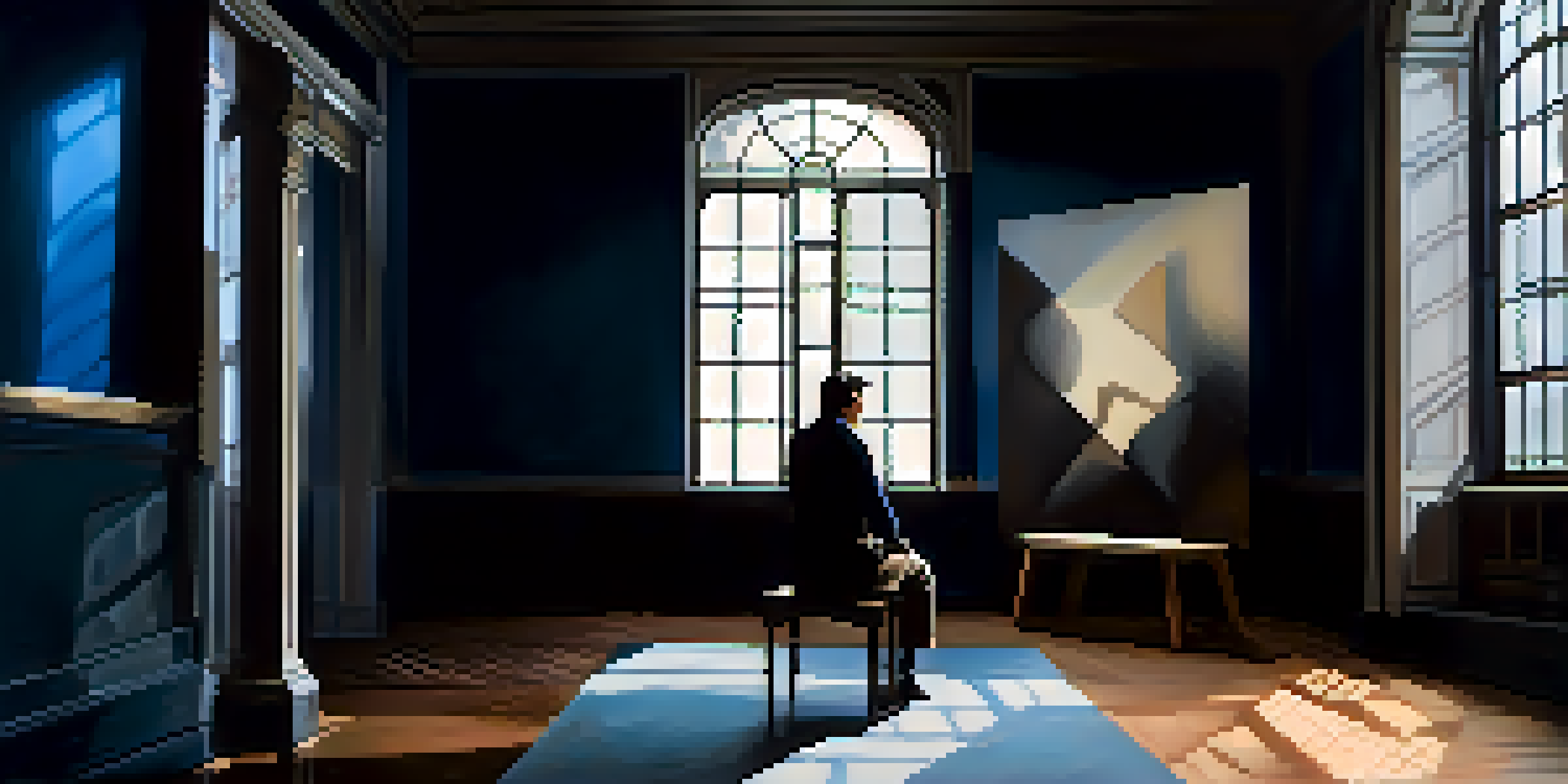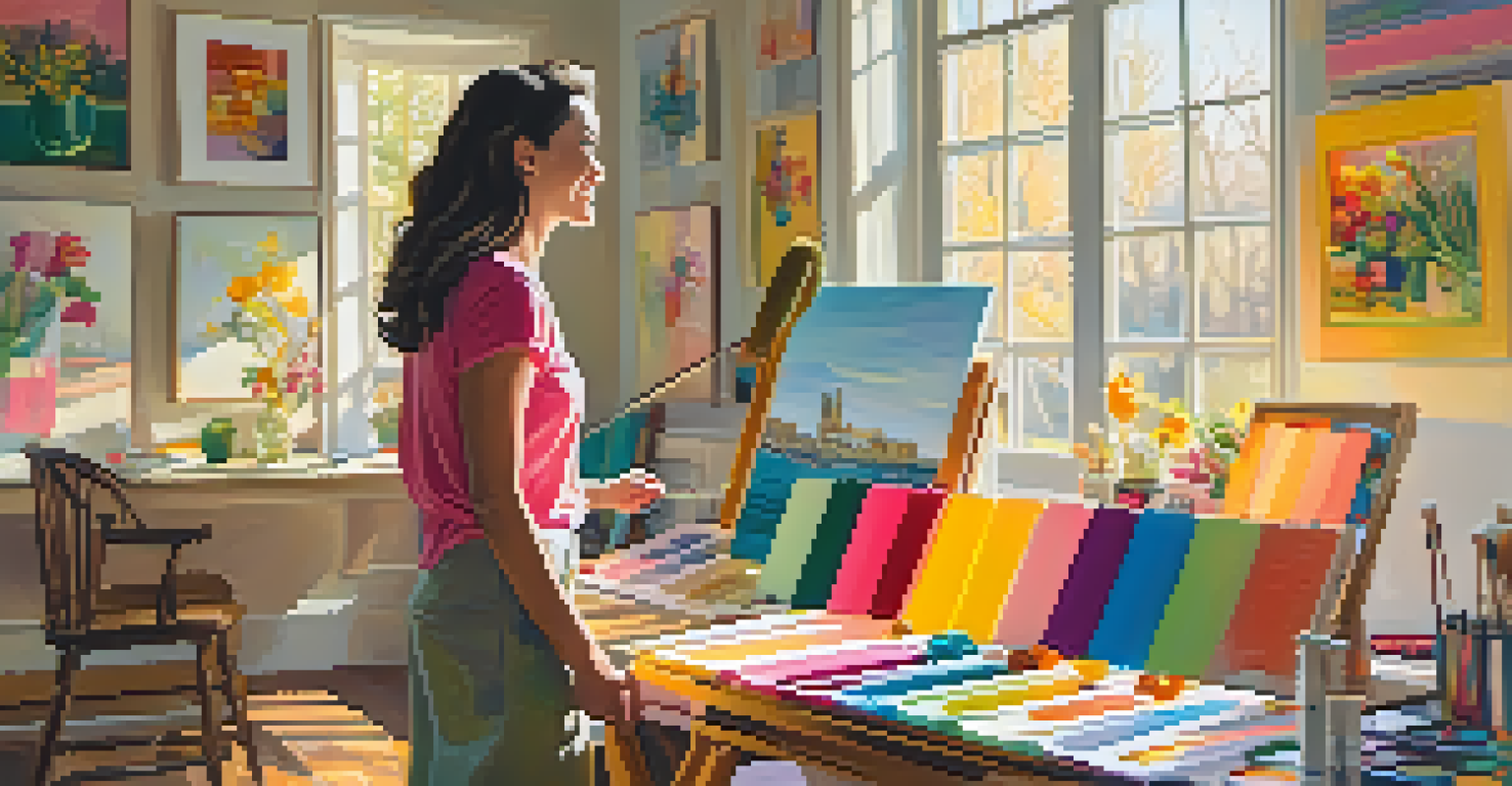Art and Emotion: Paintings' Role in Film's Emotional Impact

The Power of Visual Art in Storytelling
Visual art has a unique ability to convey emotions that words sometimes cannot. In film, paintings serve as powerful storytelling tools that can evoke feelings ranging from joy to despair. They can encapsulate the essence of a character's journey, often reflecting their inner turmoil or happiness through visual metaphors.
Art is the most beautiful of all lies.
For instance, a dark, brooding painting might symbolize a protagonist's struggle, while a bright, vibrant piece can signify hope and renewal. This visual language allows filmmakers to deepen audience engagement, inviting viewers to feel more connected to the narrative. Paintings, in essence, become silent characters that speak volumes.
Moreover, the strategic placement of artwork in a scene can subtly influence the viewer's emotional experience. Whether it’s a lingering shot of a painting or a fleeting glance, these moments can amplify the overall mood, creating a richer tapestry of storytelling that resonates long after the credits roll.
Symbolism: Paintings as Emotional Anchors
Paintings often carry profound symbolism, which filmmakers can leverage to anchor emotional themes. For example, a recurring image of a specific artwork can represent loss, hope, or conflict throughout the film. This symbolic usage helps to create a cohesive emotional thread that ties various narrative elements together.

Take the iconic use of 'The Scream' by Edvard Munch in films about existential dread; it instantly evokes a sense of anxiety and despair that aligns perfectly with the character's struggles. This connection between visual art and emotional experience allows viewers to interpret deeper meanings without explicit dialogue.
Visual Art Enhances Emotional Depth
Paintings serve as powerful storytelling tools in film, evoking emotions and creating deeper connections with the audience.
By using such symbolic imagery, filmmakers can engage audiences on a subconscious level, prompting them to reflect on their own experiences and emotions. This layering of meaning not only enriches the viewing experience but also invites discussions around the film's themes long after it ends.
Emotional Resonance Through Color and Composition
The use of color and composition in paintings can significantly influence the emotional tone of a film scene. Warm colors can evoke feelings of joy and comfort, while cooler tones might induce melancholy or introspection. Filmmakers often mimic these artistic choices to enhance the emotional landscape of their narratives.
Every artist dips his brush in his own soul, and paints his own nature into his pictures.
For instance, in a romantic film, a scene bathed in soft pastels can amplify the tenderness of a budding relationship. Conversely, a stark and contrasting composition might be used to underscore tension or conflict between characters. This visual alignment with emotional undertones creates a more immersive experience for the audience.
Additionally, the framing of artworks within a scene can highlight character dynamics or emotional stakes. A character standing in front of a chaotic painting might reflect their inner turmoil, while one in front of a serene landscape could suggest peace. These visual cues enrich the storytelling, guiding viewers’ emotional responses seamlessly.
Historical Context: Art Movements and Film Emotions
The historical context of art movements can also play a crucial role in shaping emotional narratives in film. Different eras of art reflect the cultural sentiments of their time, and filmmakers often draw inspiration from these movements to evoke specific emotions. For example, Expressionism’s focus on emotional experience can heighten feelings of anxiety and alienation in a film.
A film set in the 1920s might incorporate Expressionist paintings to evoke the tumultuous emotions of that era, enhancing the audience's understanding of the characters' struggles. This historical layering not only enriches the narrative but also serves as a reminder of how art reflects societal emotions.
Symbolism Creates Emotional Threads
Filmmakers leverage symbolic imagery in paintings to anchor emotional themes and enhance narrative cohesion.
By weaving historical art references into film, directors can create a multi-dimensional emotional experience that resonates with viewers on both a personal and cultural level. This connection to the past enriches the storytelling process and deepens emotional investment.
Case Studies: Iconic Films and Their Artistic Elements
Several iconic films showcase the powerful interplay between art and emotion, effectively using paintings to heighten impact. Take 'Girl with a Pearl Earring', where Vermeer’s artwork not only serves as a plot device but also mirrors the protagonist's emotional journey. The painting encapsulates themes of longing and unfulfilled desire, resonating with viewers on a profound level.
Another example is 'The Great Gatsby', which integrates the art deco style to reflect the opulence and moral decay of the era. The visual aesthetics of the film, including carefully chosen artworks, enhance the emotional stakes and underscore the themes of ambition and disillusionment. These artistic choices invite viewers to feel the characters' emotional highs and lows deeply.
Through these case studies, we see how filmmakers harness the power of paintings to evoke emotions, create atmosphere, and enrich storytelling. This approach not only captivates audiences but also cements the connection between art and emotional resonance in film.
The Role of Audience Interpretation in Emotional Experience
Audience interpretation plays a vital role in how paintings affect emotional experiences in film. Each viewer brings their own background, feelings, and perspectives to the screen, creating a unique emotional encounter. When a painting appears in a film, it can evoke distinct memories or feelings based on the viewer's personal experiences.
For instance, someone who has experienced loss may find deeper meaning in a film that features a painting of a desolate landscape, while another might perceive it as simply a beautiful piece of art. This subjectivity adds layers to the emotional impact of the narrative, allowing for a more personalized connection.
Audience Interpretation Shapes Experience
Each viewer's personal background influences their interpretation of art in film, adding layers to the emotional impact of the narrative.
Filmmakers often embrace this diversity of interpretation by incorporating ambiguous or open-ended artworks, inviting viewers to engage with the emotions on their terms. This dynamic relationship between art, film, and audience creates a rich emotional experience that resonates in various ways.
Future Trends: Art and Emotion in Modern Filmmaking
As filmmaking continues to evolve, the integration of art and emotion is likely to grow even more sophisticated. With advancements in technology, filmmakers are experimenting with virtual and augmented reality, allowing audiences to immerse themselves in the artistic elements of a film. This not only enhances emotional engagement but also creates a more interactive experience.
Moreover, there is a rising trend of incorporating contemporary art into film narratives, reflecting current societal issues and emotions. This shift not only keeps the storytelling relevant but also engages viewers in conversations about modern emotional landscapes and cultural contexts.

As we look ahead, the fusion of art and emotion in film will continue to inspire and challenge filmmakers and audiences alike. This ongoing dialogue between visual art and cinematic storytelling promises to deepen emotional connections, ensuring that the impact of paintings in film remains profound and lasting.